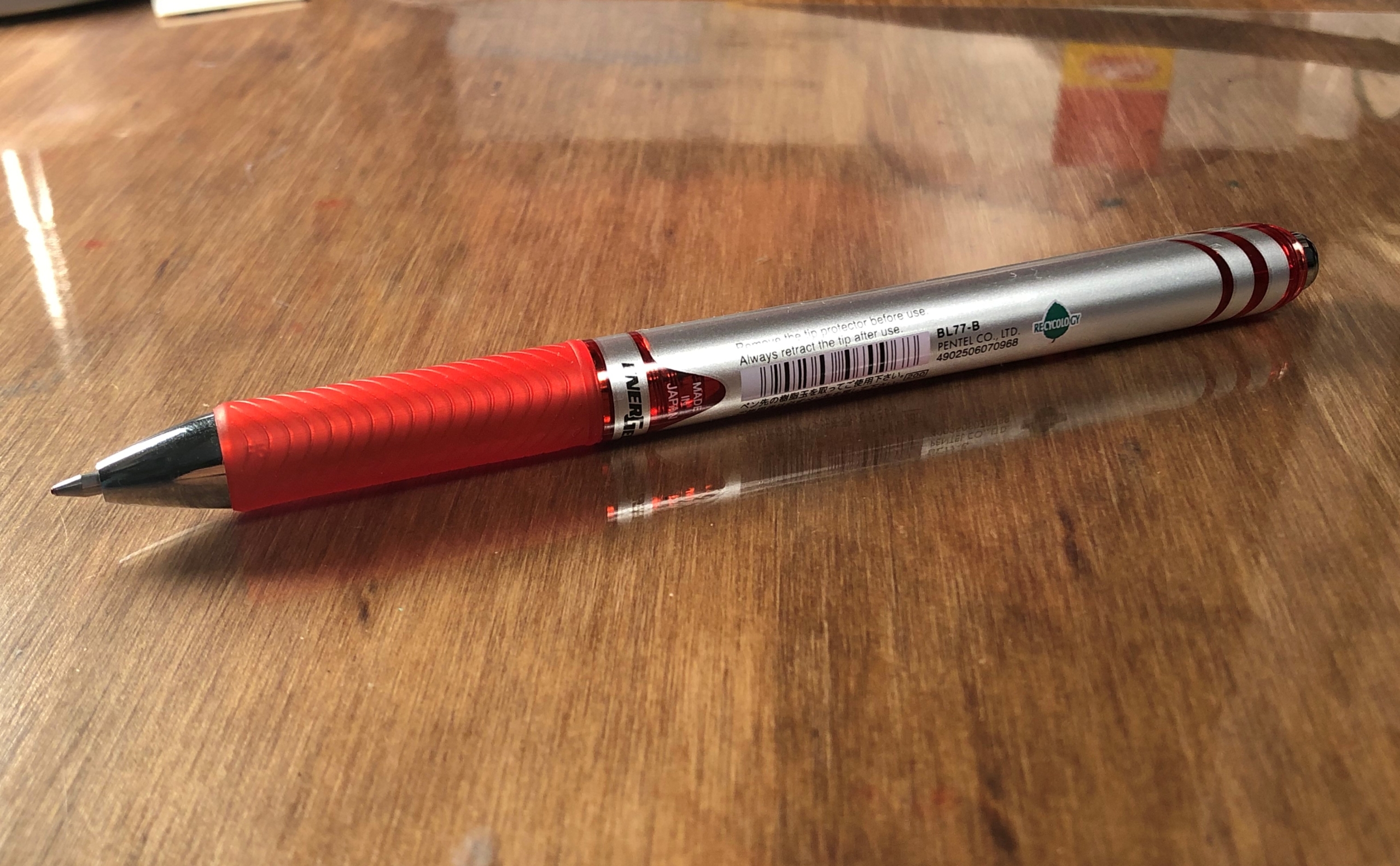The world contains layers upon layers of beauty. But do we have eyes to see all there is to see?
Sight is the physical sense. Seeing is the spiritual sense. The difference became evident to me recently when I looked up from my reading at a pen on my desk and noticed that it had a small bar code printed on it, horizontally, reduced in scale to fit exactly the narrow dimensions of the pen’s shaft. What is this? I asked myself. A single pen with a bar code!
Don’t ask me why the bar code on the pen struck me as odd on this particular day. On all other days, I have looked at that pen and all of its identical companions that came in the same box without noticing the bar code or any other distinguishing marks. On this day I noticed. Perhaps I was more receptive, more interiorly quiet and pensive.
I’ve learned that deep perception is not a matter of performing any task but of opening one’s capacities to receive. Perception of deeper reality consists of a physical opening (looking with the eyes), an intellectual opening (thinking about what you see), and, ultimately, a spiritual opening (allowing the truth of the vision to penetrate your interior).
Look closely and ponder
When the bar code jumped out at me, I decided to look more closely at the pen to see what I had missed after so many casual views of it. Apparently, I had glossed over several encyclopedias worth of information (okay, I’m exaggerating, but I’m making a point about perception here).
The bar code had some writing above and below it that contained a few lines of numbers and symbols, but every printed item was microscopic. I got out my magnifying glass.
Wow! The mystery of the microscopic print suddenly became apparent. Two tiny lines of text above the code contained some instructions for removing the plastic protective tip on the point before using the pen and a command to retract the tip into the pen shaft after every use.
It occurred to me that writing anything in infinitesimally small print rather defeats the purpose of instructions if no one can read them. Hmmm.
There was also a product number to the right of the bar code, a brand name, and some kind of tiny green symbol which, I think, indicated compliance with certain environmentally-friendly recycling regulations so that some government somewhere wouldn’t quarantine the lot and inhibit sales in a given country. Another Hmmm. Apparently, even pens are not immune from politics.
Below the bar code I could see two lines of characters written in a mysterious oriental language – Chinese? Korean? Thai? Looking further down the shaft toward the tip I noticed a compact message (this one could actually be read by the naked eye): “Made in Japan”. Mystery solved, I guess. I’m also going to presume that the characters spelled out the same instructions for removing the plastic protective tip, etc. because everyone on earth needs to be instructed about how to do common sense things.
Continuing the magnifying glass examination was a fascinating journey into the wonders of color, texture, and design. Various signs and symbols on the outside told me that the pen contained “liquid gel ink” – ruby red. It had a “metal tip” which was made of a 0.7 millimeter ball point. Its fully plastic body was adorned with two shades of silver (shiny and matte), two kinds of red substances (translucent plastic and rubberized grip), as well as a few design stripes at the top that tried hard to look cool.
Then I sensed something deepening in me as I looked at the details of the pen: This homely little piece of technology is truly marvelous. It is beautiful in its own way.
I thought of those iPhone commercials where the phone seems to be floating in mid-air while they show you close-ups of the sleek design, brilliant screen colors, icons, functionality, etc. Fast food advertisements employ the same tactic when they plaster highly detailed images of their food on the sides of semi-trucks to tantalize consumer taste buds. Far away images don’t make you salivate.
But there is a reason why people selling things use close-ups: detail reveals truth, and truth is attractive. If only we have eyes to see.
Then contemplate what you see
A few more worlds opened up to me as I looked closely at the pen. Noticing the physical details is one thing, thinking about their meaning is another. This requires a more contemplative approach to what we see.
For example, plastic. No one – in the entire history of humanity prior to the 20th century – has experienced the benefits of plastic. (I’m aware that there are deficits to it also, but for the sake of argument, let’s stick with the wonders of this modern substance!)
If I were more technically inclined, I could describe the complex molecular chemistry of various plastics, but the details of that technology do not need to be explained to know that plastic is a true phenomenon of modern science, which in turn is a product of an Industrial Revolution and a modern economy, which in turn are products of Enlightenment learning, Renaissance art culture, and even in some remote way, Medieval philosophy, etc.
Wonders upon wonders. For those who have eyes to see.
The point is not that we must understand the complex details of everything we see but that we must enter into the wonder of things. The external dimensions of everything point to a certain inner world that will open up only to those whose minds and hearts receive its truth.
The wonder is personal
Contemplating our humble writing instrument further, I imagined a person sitting at a drafting table or a computer and designing my pen. It didn’t pop into existence all on its own. This man or woman conceived of the idea of two shades of silver intertwined with two types and textures of ruby red to make up the shaft and then put it on paper as a design for someone else to produce.
Did they also design the complex internal mechanism of the ink cartridge that the pen-users in several Asian and Western nations were ordered, by the markings, to retract after use? Probably not. Different specialization. I then imagined some other college-educated person sitting at an engineer’s table figuring out how to deliver to his boss a smoothly-retracting cartridge with liquid gel ink and a 0.7 millimeter ball bearing in the tip that would work without catching or jamming.
And how did that pen land on my desk, specifically? Engineering, manufacturing, shipping, warehousing, logistics, accounting, sales reports, modern credit financing, the stocking of shelves, etc. – all of these networks and institutions conspired to put that red pen under the magnifying glass for my viewing pleasure that day.
But all these functions are carried out by human beings who work individually, or as teams and systems; human beings who have families, emotions, aspirations, and souls. Just like me.
Wonders upon wonders.
Many-layered reality
The pen is just a human object. Even its simple design, however, manifests a complexity that should amaze anyone who takes the time to look under its plastic surface. Imagine the wonder of more complex human designs and programs like computers, space travel, engines, bridges, buildings, the Internet.
And these are only human creations. Dare we look closely at the wondrous creations and designs of the natural world? (More on these in future posts.)
Our beautiful world is many-layered and deeper than the eye can see. But we have to open our eyes to see it. Sight is the sense. Seeing is the capacity.
And when we contemplate the world we’ve been given, we can’t help but notice what a true gift it is. God has freely given it to us with no strings attached except that we be good stewards of it. We should be awestruck by its beauty and integrity and truth.
We can’t appreciate these dimensions of our world when we’re caught up in it. We can only behold them by stepping back and deliberately seeing them.
We then begin to enter into another world that lies beyond our own or perhaps surrounds it. Maybe our world is just one element or dimension of that more magnificent world, like each human object and natural creation is one dimension of our wondrous physical world.
Only when we develop the capacity to contemplate “what eye has not seen, what ear has not heard, what has not entered into the mind of man” (1 Corinthians 2:9) do we begin to enter the world of the angels, the world of eternity that surpasses all understanding.
Our first step into that world begins with contemplating the wonder of a pen.

Soul Work
Slow down and look closely at one object today. Just one. Give it your undivided attention for three or four minutes only.
Notice all the details of the physical object. Think about its “messages” and the wider world it opens up. Contemplate the human dimension that produced it. Wonder at it all.
Then raise your heart in praise to God and ask Him for the grace to always have eyes to see, ears to hear, and a heart to love the wonders we can only see with our spiritual senses.




Leave A Comment